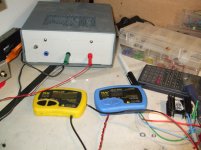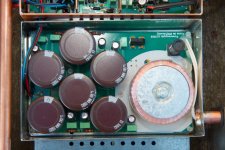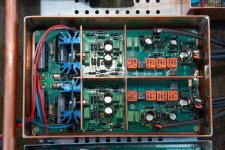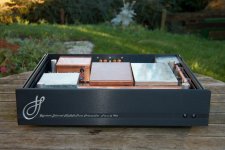I am verry sorry to ear you will be posting one last circuit
This has been a realy stimulating tread and I have been learning a lott from you all.
I am shure this will carry on trough the development of the Paradise and well who know about tomorows parties..
I will be ever so gratefull for all your efforts (this to include all other contributors)
Just for a change maybe this help....
Red and Black vires conected to a 317 set at 12.5 V and soldered to the inside batteri clips works even in the midle of the night when batteries shoop is closed.
This has been a realy stimulating tread and I have been learning a lott from you all.
I am shure this will carry on trough the development of the Paradise and well who know about tomorows parties..
I will be ever so gratefull for all your efforts (this to include all other contributors)
Just for a change maybe this help....
Red and Black vires conected to a 317 set at 12.5 V and soldered to the inside batteri clips works even in the midle of the night when batteries shoop is closed.
Attachments
Yes, i will work with Sampler on the Starless Balanced as I chose to call it. When that circuit works to our satisfaction i am planning to make a PCB. So we have the Paradise and the Starless. This two circuits contain most of the know how i put into this thread plus all i learned in a period of nearly 3 years. I honesty do not know how to make better circuits for DIY. Trust me, the Paradise needs experience to stuff and a lot can go wrong.
I will focus to help people to make this two final circuits work and we can always discuss new ideas and details. So i will still be active here but not making any new designs from beginning to end. You have to agree that the level of technology and innovation is very high in both circuits. I would be hard pressed to design something better without going totally over the top with complexity plus using expensive; exotic parts and construction methods. I really think this is the maximum that a medium experienced amateur builder can manage without too much frustration.
I will focus to help people to make this two final circuits work and we can always discuss new ideas and details. So i will still be active here but not making any new designs from beginning to end. You have to agree that the level of technology and innovation is very high in both circuits. I would be hard pressed to design something better without going totally over the top with complexity plus using expensive; exotic parts and construction methods. I really think this is the maximum that a medium experienced amateur builder can manage without too much frustration.
Yes, i will work with Sampler on the Starless Balanced as I chose to call it. When that circuit works to our satisfaction i am planning to make a PCB. So we have the Paradise and the Starless. This two circuits contain most of the know how i put into this thread plus all i learned in a period of nearly 3 years. I honesty do not know how to make better circuits for DIY. Trust me, the Paradise needs experience to stuff and a lot can go wrong.
I will focus to help people to make this two final circuits work and we can always discuss new ideas and details. So i will still be active here but not making any new designs from beginning to end. You have to agree that the level of technology and innovation is very high in both circuits. I would be hard pressed to design something better without going totally over the top with complexity plus using expensive; exotic parts and construction methods. I really think this is the maximum that a medium experienced amateur builder can manage without too much frustration.
Tanks Joachim
The paradise is what I have been looking for to realy understand transistor circuit.
I had a "bit" of experience on the road and in radio stations/ recording studios to get to understand a bit about electronics but mostly with the 8 legged kind and normaly just rush repairs to keep the show going.
I would electronic wise consider myself Just a half decent Mechanic
You Sir just got me to want to learn new things...
And
You welcome
This is a bit off topic but interesting :Superconductors and Superconducting Materials Information on GlobalSpec
Sampler, you are still working on the circuit but i have a question :
Why did you put in the 2.2kOhm resistors into the base feeds ? In a conventional ground referenced cascode this would slow down the circuit and ad uncorrelated noise in the amount of the square root of the base resistor. The noise plots look fine though. I can only speculate that you trimmed an overshot and the noise circulates locally but does not add to the input noise. What is also unusual is that the balanced connection lowers the noise by ca.5dB in the bass. There is only one harmonic sticking out in proportion but that is not more then the noise at that frequency of the unbalanced condition. In a conventional balanced stage you get more gain but noise worsens by 3dB with the same amount of input devices. When you want the noise of 2 Fets in parallel, unbalanced, you need 4 Fets for balanced.
Sampler, you are still working on the circuit but i have a question :
Why did you put in the 2.2kOhm resistors into the base feeds ? In a conventional ground referenced cascode this would slow down the circuit and ad uncorrelated noise in the amount of the square root of the base resistor. The noise plots look fine though. I can only speculate that you trimmed an overshot and the noise circulates locally but does not add to the input noise. What is also unusual is that the balanced connection lowers the noise by ca.5dB in the bass. There is only one harmonic sticking out in proportion but that is not more then the noise at that frequency of the unbalanced condition. In a conventional balanced stage you get more gain but noise worsens by 3dB with the same amount of input devices. When you want the noise of 2 Fets in parallel, unbalanced, you need 4 Fets for balanced.
Room-Temperature Superconductivity in a Copper Oxide
Superconductor @ 28 C
Now a couple undred meter coil of vire and hey presto MC trafo whitout pain
Just a couple of caps for RIAA filter then straight to speakers
No not realy but...
Superconductor @ 28 C
Now a couple undred meter coil of vire and hey presto MC trafo whitout pain
Just a couple of caps for RIAA filter then straight to speakers
No not realy but...
I always thought that beta building/testing is intended for all concerned to work to exactly the same design with the intention of helping the designer prove his work. Otherwise - interesting as variations may be - there is no common reference....and, more importantly, there is inadequate testing of the design itself. It must be that all builders stick with the official design and that variations for specific requirements are incorporated AFTER the beta versions have been tested and de-bugged. Of course the designer may well ask or approve one or two trusted beta builders to make specific changes to the original.
I, too, would like to thank Joachim for all of the work which he has done in keeping this his thread fed with excellent design concepts and reports of his detailed work. As well as preaching to the converted and 'Old Faithful' his work is sure to have lit a light for those who are too young to have any real experience of the 'Pre CD' life!!!
to have any real experience of the 'Pre CD' life!!!
I, too, would like to thank Joachim for all of the work which he has done in keeping this his thread fed with excellent design concepts and reports of his detailed work. As well as preaching to the converted and 'Old Faithful' his work is sure to have lit a light for those who are too young
Posting on the Net always creates noise and i produced some heavy noise too, intentional or not. Hesener has build to spec. I will build two pairs to spec. So we have at least three.
Hesener compared to the FPS that has plus-minus 0.1dB, fine tuned by non less then Sigurd Ruschkowsky. Hesener does not claim to have golden ears but in fact he may be a much less biased listener then most. The stages sounded in many ways similar, so the Pardise as is is not very far off. MiiB promised plus-minus 0.3dB with the biggest deviation in the bass, that is a slight rise. After some confusion about the "official" version that was confirmed in Samplers simulation. I like that tuning best in MY system anyway. But i have a cartridge that is not shy in treble and really dislikes stages that are tilted up in the treble the other way around then the Paradise. Many famous stages do exactly that to sound more "dynamic" "exiting" " more speed" etc. in the showroom. The review may tell the total opposite. There is simply no standard any more. The Paradise allows mathematical exact RIAA anyway. Ricardo came up with one solution, Sampler with another, Ricardo came back with a third solution and then Sampler found a compromise. EVEN when all this solutions fall in the plus-minus o.1dB class they will sound slightly different because distortion, dynamic range and slewing are all intermingled in a transimpedance RIAA. That is the nature of the beast.
Hesener compared to the FPS that has plus-minus 0.1dB, fine tuned by non less then Sigurd Ruschkowsky. Hesener does not claim to have golden ears but in fact he may be a much less biased listener then most. The stages sounded in many ways similar, so the Pardise as is is not very far off. MiiB promised plus-minus 0.3dB with the biggest deviation in the bass, that is a slight rise. After some confusion about the "official" version that was confirmed in Samplers simulation. I like that tuning best in MY system anyway. But i have a cartridge that is not shy in treble and really dislikes stages that are tilted up in the treble the other way around then the Paradise. Many famous stages do exactly that to sound more "dynamic" "exiting" " more speed" etc. in the showroom. The review may tell the total opposite. There is simply no standard any more. The Paradise allows mathematical exact RIAA anyway. Ricardo came up with one solution, Sampler with another, Ricardo came back with a third solution and then Sampler found a compromise. EVEN when all this solutions fall in the plus-minus o.1dB class they will sound slightly different because distortion, dynamic range and slewing are all intermingled in a transimpedance RIAA. That is the nature of the beast.
Last edited:
Just been up in the loft to get same work done temperature there is 7.6 C
So I am going to draw a PCB or 2
So far I had no Feed back from Frans about the rectifier board...
Sorry for that, I am currently on a 'away mission' takes another few day's
Regards,
Frans.
Ok, I'm back from frozen hell of -24, and it should hit -32 this night... time to turn on soldering iron and mono blocks, class A saves lives this winter I hear  Joachim, I'm sorry to hear that you decided to step back after this last incarnation of great ideas, but I understand as it really takes much time, and is addictive I should add. Anyhow, all this thread produced so much food for thoughts, that anyone starting from page 1 has more then enough digesting to do for all tastes and preferences out there.
Joachim, I'm sorry to hear that you decided to step back after this last incarnation of great ideas, but I understand as it really takes much time, and is addictive I should add. Anyhow, all this thread produced so much food for thoughts, that anyone starting from page 1 has more then enough digesting to do for all tastes and preferences out there.
I will take out that 2.2k to bases, it's just for connection convenience in my proto. I just wanted to check CMRR quickly, and fact that there was still mains garbage visible got me puzzled, also noise floor decrease looks not right. There must be mistake somewhere, I'll recheck it. Also I should elaborate, that this mains grass is picked only by cartridge, if I take headshell off, there is nothing more then clean noise floor of stage, so now wonder that DL103 in metal case like zulu in spite mechanical reasons sound different. At least with se stages that is.
I will take out that 2.2k to bases, it's just for connection convenience in my proto. I just wanted to check CMRR quickly, and fact that there was still mains garbage visible got me puzzled, also noise floor decrease looks not right. There must be mistake somewhere, I'll recheck it. Also I should elaborate, that this mains grass is picked only by cartridge, if I take headshell off, there is nothing more then clean noise floor of stage, so now wonder that DL103 in metal case like zulu in spite mechanical reasons sound different. At least with se stages that is.
Sampler, cabling and earthing is extremely critical when we go down in self noise so low.
Actually it can be quite frustrating to get it right.
"Never give up" Dr. Peter Forsell
Frans has shown the way on his balanced phonostage thread. He put all the circuit elements in closed copper compartments and rooted the cables through copper tubes.
Actually it can be quite frustrating to get it right.
"Never give up" Dr. Peter Forsell
Frans has shown the way on his balanced phonostage thread. He put all the circuit elements in closed copper compartments and rooted the cables through copper tubes.



